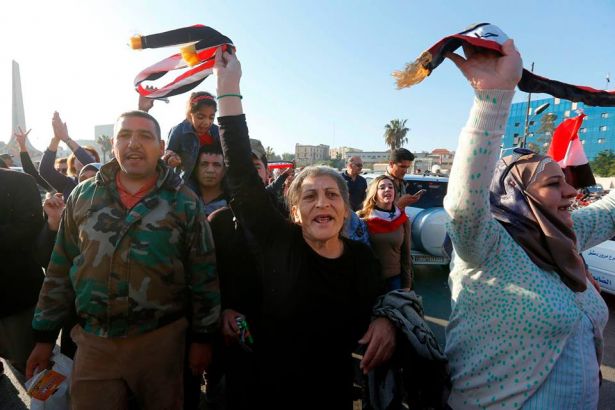Syria challenges claims about 'success' of US-led strikes

Hundreds of Syrians across the country poured into the streets on Saturday, dancing and chanting in defiance of the failure of the imperialist powers' strikes on Syria.
People were waving Syrian flags and chanting anti-US slogans, condemning the attack and praising the efforts of Syria’s armed forces, which managed to intercept a large number of incoming missiles.
"Good souls will not be humiliated," Syria's presidential account tweeted after the airstrikes began. Later, a video showing Syrian President Bashar al-Assad walking into his office carrying a briefcase was posted on the same account. "Good morning, steadfastness," the caption read.
These messages later mixed with celebrations over the news that the Syrian army declared the eastern suburbs of Damascus fully liberated after the last group of terrorists left the town of Douma.
Late Friday the US, UK, France launched the coordinated airstrike in Syria, under the pretext of the unsubstantiated international campaign about the use of chemical weapons in the Syrian town of Douma.
On Saturday, US President Donald Trump, British Prime Minister Theresa May and French President Emmanuel Macron huddled by telephone to discuss their joint action. "The three leaders agreed that the military strikes taken against the Syrian regime's chemical weapons sites had been a success," Downing Street said in a readout of the calls.
However, the Russian military claimed Syrian air defense systems had intercepted 71 Western missiles.
SOVIET-MADE SYSTEMS REPELLED THE ATTACKS
Perhaps the most surprising news surrounding the US, British and French strike was the report that the country's Air Defense Force managed to shoot down just shy of 70% of the Western cruise missiles launched.
According to the Russian Defence Ministry, of the 103 cruise missiles launched by the US, Britain and France, 71 were intercepted by Syria’s air defences.
Furthermore, although the Syrian military does have some modern air defenses, the cruise missile attack was repelled mostly by upgrades of 30+ year old equipment, including variants of the Buk self-propelled missile system, the S-125 air defense system, and the S-200, an aging but tried and tested SAM introduced into the Soviet military in the late 1960s, reports said.
Overall, 71 missiles were fired at 6 airfields. Of these, only 7 could reach their targets, including 4 at the disused Mezzeh air base, and 3 at Homs. No serious damage to infrastructure was inflicted. Of these, 7 were intercepted. The rest hit the empty sites with no people or equipment in place.
Russian air defence units did not participate as no missile entered their areas of responsibility, Moscow says.
CHILDREN'S TOY
Several missiles hit a research centre in Barzeh, north of Damascus, "destroying a building that included scientific labs and a training centre," SANA reported.
The site, according to imperialist powers, was part of the Syrian government's "chemical weapons infrastructure."
But Said Said, an engineer who identified himself as head of the centre's paint and plastics department, told Associated France Press only non-lethal research and development was under way at the centre.
"As we work in civilian pharmaceutical and chemical research, we did not expect that we would be hit," he said.
Instead, the centre had been producing antidotes to scorpion and snake venom while running tests on chemical products used in making food, medicine and children's toys, according to Said.
"If there were chemical weapons, we would not be able to stand here. I've been here since 5:30 am in full health -- I'm not coughing," he added.
Said said the Organisation for the Prohibition of Chemical Weapons (OPCW) had visited the site in Barzeh in recent years and had declared it free of any toxic weapons.
'STRIKES AIMED TO UNDERMINE ACTIVITIES OF THE CHEMICAL WATCHDOG'
The strikes on Syria are aimed to undermine activities of the mission of the OPCW, and to exert pressure on experts, Syrian Ambassador to the United Nations Bashar Ja'afari said. On Saturday, the OPCW press service said the organization's mission had arrived in Damascus. After the announcement, France, the United Kingdom and the United States fired missiles on Syria.
Ja'afari said that it was surprising that if the representatives of the three Western states had been aware of the alleged presence of the facilities, which they claimed were linked with chemical weapons production, why they had not informed the OPCW about this fact.
MATTIS DISCLOSED THE U.S. HAD NOT YET CONFIRMED THE 'CHEMICAL ATTACK'
On Friday, U.S. Defense Secretary Jim Mattis disclosed that the U.S. had not yet confirmed that the alleged Syrian chemical weapons attack, on April 7 in the Damascus suburb of Douma, included the use of sarin gas. He said at least one chemical was used - chlorine, which also has legitimate industrial uses and had not previously triggered a U.S. military response.
On Thursday, Mattis told Congress that the US military does not have evidence that either chlorine or sarin was used in an alleged chemical attack in the Syrian town of Douma, adding that the Pentagon's only proof that such an incident occurred has come from social media and media reports.
The US conclusion on the alleged chemical attack in Syria was based on media sources and ‘reliable information’, the White House said in a statement after US, Britain and France launched the strike.




